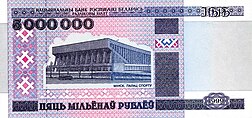Belarusian rouble
| Belarusian ruble | |
|---|---|
|
беларускі рубель (Belarusian) белорусский рубль (Russian) |
|

500 ruble banknote (second ruble, obverse)
|
|
| ISO 4217 | |
| Code | BYN |
| Denominations | |
| Subunit | |
| 1/100 | kapiejka |
| Plural | The language(s) of this currency belong(s) to the Slavic languages. There is more than one way to construct plural forms. |
| Symbol | p. |
| Banknotes | |
| Freq. used | 5, 10, 20, 50, 100 rubles |
| Rarely used | 200, 500 rubles |
| Coins | |
| Freq. used | 1, 2, 5, 10, 20, 50 kapiejkas, 1, 2 rubles |
| Demographics | |
| User(s) |
|
| Issuance | |
| Central bank | National Bank of the Republic of Belarus |
| Website | www |
| Valuation | |
| Inflation | 12.0% |
| Source | National Statistical Committee, December 2015 |
The Belarusian ruble (Belarusian: рубель rubieĺ, plural: рублі rubli, genitive plural: рублёў rublioŭ) is the official currency of Belarus. The ruble is subdivided into 100 kopeks (Belarusian: капейка kapiejka, plural: капейкі kapiejki, genitive plural: капеек kapiejek). The symbol for the ruble is Br and the ISO 4217 code is BYN.
As a result of the breakup of the supply chain in the former Soviet enterprises, goods started to be bought and sold in the market, often requiring cash settlement. The Belarusian unit of the USSR State Bank had neither the capacity nor the licence to print Soviet banknotes, so the government decided to introduce its own national currency to ease the cash situation. The German word Taler (Belarusian: талер), divided into 100 hrosh (Belarusian: грош) was suggested as the name for a Belarusian currency; but the Communist majority in the Supreme Soviet of Belarus rejected the proposal and stuck to the word ruble that was usual for Belarus from the times of the Soviet Union and the Russian Empire. In the medieval Grand Duchy of Lithuania of which Belarus was a major part, the word ruble has also been used as a name for a currency in circulation (see Lithuanian long currency).
From the collapse of the Soviet Union until May 1992, the Soviet ruble circulated in Belarus alongside the Belarusian ruble. New Russian banknotes also circulated in Belarus, but they were replaced by notes issued by the National Bank of the Republic of Belarus in May 1992. The first post-Soviet Belarusian ruble was assigned the ISO code BYB and replaced the Soviet currency at the rate of 1 Belarusian ruble = 10 Soviet rubles. It took about two years before the ruble became the official currency of the country.
...
Wikipedia
